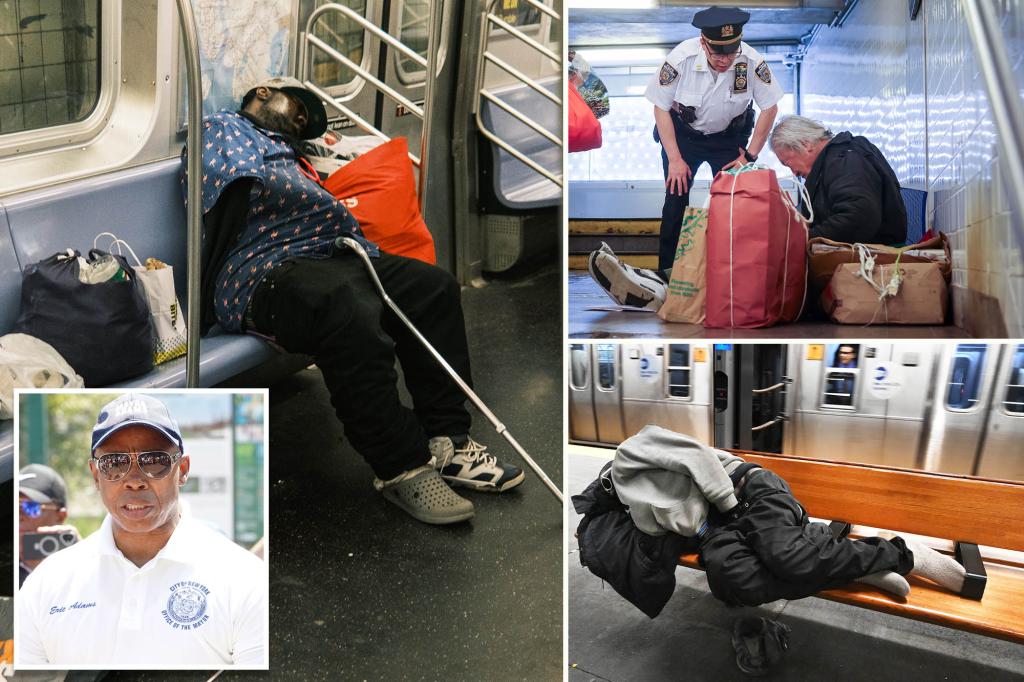Over 3,500 homeless New Yorkers have been taken off Big Apple streets and subways and placed in permanent housing since the start of Mayor Eric Adams’ term, Hizzoner announced on Monday — touting it as proof that his “Subway Safety Plan” is working.
Over 1,000 of the housing placements came directly from the subway system since the plan launched in early 2022 as part of a broader effort to curb the ongoing homelessness crisis in transit stations, officials said.
Over 3,500 homeless New Yorkers have been taken off Big Apple streets and subways and placed in permanent housing since Mayor Adams’ “Subway Safety Plan” was launched in early 2022. Tomas E. Gaston
The campaign will also focus on efforts made to “change the culture” and laws around seeking mental health. Stephen Yang
The recent milestone is the centerpiece of Adams’ new “End Anything Goes” campaign — a push to show how his administration is cracking down on public disorder while expanding services for New Yorkers with mental illness and addiction, City Hall announced.
The campaign will highlight the current efforts the administration has made to date to “change the culture” and laws that have prevented mentally ill New Yorkers from seeking help — while also making investments to support outreach, harm reduction, and housing, Adams said.
“From the beginning, we said we needed to build trust with the city’s unsheltered population, whether outside, on our subways, or in our shelters,” Adams said in a statement.
“This success would not be possible without our historic investments,” the mayor said, crediting Safe Haven beds, outreach teams, and a “record-breaking creation of affordable housing.”
“More work remains, but it’s clear that the years of walking by New Yorkers in need are over, and this milestone is further proof that we’re continuing to make New York City a safer, more affordable city.”
Since launching the multi-agency Subway Safety Plan, the city has connected 8,600 people to types of shelter, with over 1,000 now in permanent homes. The effort focuses on outreach at stations to pull people with serious mental health issues out of the transit system.
The milestone is the centerpiece of Adams’ new “End Anything Goes” campaign — a public push to show how his administration is cracking down on public disorder while expanding services for New Yorkers with mental illness and addiction. Michael Nagle
The MTA said this July had the lowest transit-crime stats since 1995 when the data was first collected, with an 8% drop in felonies in the subways last month — even as a string of violent crimes in the subway system recently left a straphanger slashed and another shoved onto the tracks by a muttering maniac.
Hizzoner also touted the city’s growing network of shelter beds, with 400 more Safe Haven beds to house the homeless and transition them to permanent housing to be added by the end of 2025.
So far, 1,600 new beds have been added since Adams took office, City Hall said.
Adams introduced a $650 million plan to tackle homelessness and get mentally ill New Yorkers off the streets and out of subways during his State of the City speech in January – begging Albany for more help tackling the Big Apple’s ongoing crisis.
The ambitious, five-year proposal — which is set to include a special new facility to house and treat mentally ill New Yorkers — follows a spate of frightening underground attacks that have plagued the transit system of late.
The MTA said this July had the lowest transit-crime stats since 1995 when the data was first collected. Helayne Seidman
As part of the plan, a $13 million “pilot program,” as described by a City Hall rep, would create a 100-bed supportive housing facility that would provide shelter to people leaving psychiatric facilities who are not yet ready to fully live alone without support to continue their meds and treatment, officials said.
The initiative would also add 900 “Safe Haven” beds, which will be spread across the city, to house the homeless and transition them to permanent housing — bringing the total to 4,900. An additional 100 beds will also be added to serve runaway and homeless youth ages 21-24.
And a new “Bridge to Home” model under the proposal will offer home-like environments to patients with serious mental illnesses at NYC Health + Hospitals.
The program will target patients who are ready to be discharged from hospitals but have nowhere to go home to, officials said.
